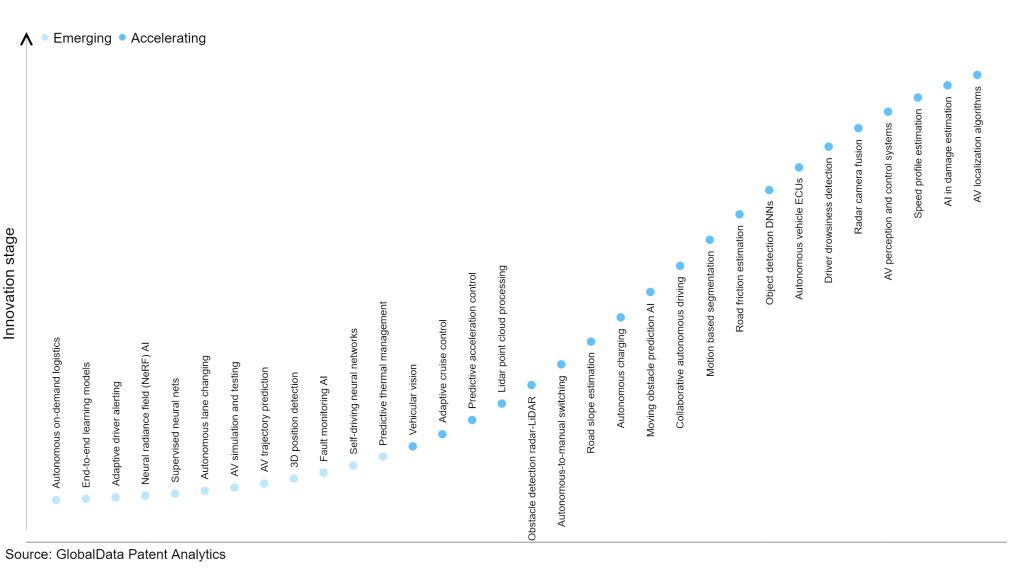The automotive industry continues to be a hotbed of patent innovation. Activity is driven by growing demand for autonomous vehicles (AVs), the need for high-performance AV localization algorithms, and growing importance of technologies such as artificial intelligence (AI), machine learning (ML), and sensor technology. In the last three years alone, there have been over 1.7 million patents filed and granted in the automotive industry, according to GlobalData’s report on Artificial intelligence in automotive: AV localization algorithms. Buy the report here.
However, not all innovations are equal and nor do they follow a constant upward trend. Instead, their evolution takes the form of an S-shaped curve that reflects their typical lifecycle from early emergence to accelerating adoption, before finally stabilizing and reaching maturity.
Identifying where a particular innovation is on this journey, especially those that are in the emerging and accelerating stages, is essential for understanding their current level of adoption and the likely future trajectory and impact they will have.
300+ innovations will shape the automotive industry
According to GlobalData’s Technology Foresights, which plots the S-curve for the automotive industry using innovation intensity models built on over one million patents, there are 300+ innovation areas that will shape the future of the industry.
Within the emerging innovation stage, autonomous on-demand logistics, end-to-end learning models, and adaptive driver alerting are disruptive technologies that are in the early stages of application and should be tracked closely. Vehicular vision, adaptive cruise control, and predictive acceleration control are some of the accelerating innovation areas, where adoption has been steadily increasing.
Innovation S-curve for artificial intelligence in the automotive industry

AV localization algorithms is a key innovation area in artificial intelligence
AV localization algorithms refer to algorithms used in autonomous vehicles to locate and map their position in the environment in real-time and generate efficient maps and routes. These algorithms rely on various sensor data and GPS in combination with machine learning and statistical methods to accurately localize the vehicle, detect errors in the current map data and update it when required.
GlobalData’s analysis also uncovers the companies at the forefront of each innovation area and assesses the potential reach and impact of their patenting activity across different applications and geographies. According to GlobalData, there are 20+ companies, spanning technology vendors, established automotive companies, and up-and-coming start-ups engaged in the development and application of AV localization algorithms.
Key players in AV localization algorithms – a disruptive innovation in the automotive industry
‘Application diversity’ measures the number of applications identified for each patent. It broadly splits companies into either ‘niche’ or ‘diversified’ innovators.
‘Geographic reach’ refers to the number of countries each patent is registered in. It reflects the breadth of geographic application intended, ranging from ‘global’ to ‘local’.
Patent volumes related to AV localization algorithms
Source: GlobalData Patent Analytics
Intel is one of the leading patent filers in the field of AV localization algorithms. It is currently working on developing new AI and ML algorithms that are more accurate and efficient than traditional AV localization algorithms. These new algorithms can better perceive the surrounding environment and make decisions about the vehicle's position and orientation. Additionally, Intel is working on a new hardware platform for AV localization based on its latest-generation Xeon processors. This new platform is more powerful and efficient than traditional hardware platforms, enabling it to run Intel's new AI and ML algorithms in real-time. Some other key patent filers in this space include NVIDIA, INRIX, and Baidu.
In terms of application diversity, Nio leads the pack, while INRIX and DJI Technology stood in the second and third positions, respectively. By means of geographic reach, INRIX held the top position, followed by Nio and Intel.
To further understand the key themes and technologies disrupting the automotive industry, access GlobalData’s latest thematic research report on Artificial Intelligence (AI) in Automotive.
Data Insights
From

The gold standard of business intelligence.
Blending expert knowledge with cutting-edge technology, GlobalData’s unrivalled proprietary data will enable you to decode what’s happening in your market. You can make better informed decisions and gain a future-proof advantage over your competitors.







